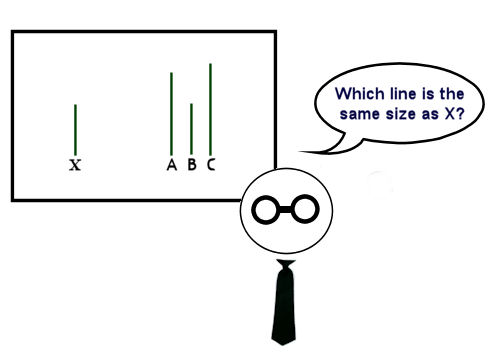In Chapter 2 we briefly discussed social groups a parts of social structure. Students learned about the size of a group (dyad, triad), and the level of intimacy (primary, secondary). In this chapter, students will gain a more detailed understanding of how groups operate and how they influence individuals. To emphasize, sociologists distinguish between social aggregates, social groups, and social categories. Social categories refer to people sharing a common characteristic or feature (race, gender); social aggregates are people who happen to be at the same place at the same time (people in the elevator). Sociologists limit their categorization of social groups to people who interact with each other on a regular basis, share similar goals and values, and are aware of belonging to a group such as a sports team, religious group, knitting club etc.
Groups, especially as they grow in size often are organized in a hierarchical system. Groups can have leaders and members or followers. Leaders can either be formally or informally placed in power. Formal leadership happens when there is some codified process or traditional method for choosing a leader, such as elections. On the other hand, informal leadership occurs when a person or a group of people have control, but their positions of power were not achieved through a formal process. An example would be a group of five friends. Without anyone declaring a formal leader, there might be person or two whose decisions are regularly followed without a formalized process.
One aspect of belonging to a group is conformity. William H. Whyte, Jr (1917-1999) coined the term groupthink, and Irving Janis (1918-1990) expatiated on the concept. Janis defines groupthink as “a mode of thinking that people engage in when they are deeply involved in a cohesive in-group, when the members striving for unanimity override their motivation to realistically appraise alternative courses of action (Janis, 8, 1977).” The concept of groupthink has been used to assess the disastrous launch of the space shuttle Challenger in 1986 (Moorhead et. Al 1991). The Challenger space shuttle exploded 73 seconds after take off, killing all seven astronauts aboard. Even though some engineers feared that the high crosswinds at the launch site on the scheduled take off, the shuttle was nonetheless launched. Researchers believe that “cohesive group,” “leader preference,” and “insulation from experts” were the “antecedent conditions” for group think. People are less likely to challenge the group with cohesion. Leaders may have a preference for certain decisions and will promote and listen to advisers whom they already agree with, and hierarchy and structure may insulate those who are making the top decisions from the people in the bottom doing the daily work. Pressure to dissent within the group, specifically against the top level management of NASA, led engineers to conform, and the feeling of invulnerability in their work led the top engineers to ignore the opinions of the lower-level engineers.
Experiments of groupthink and conformity, where the environment is controlled, has to disturbing results. Solomon Asch (1907-1996) was a social psychologist interested in analyzing the effects of social pressure on an individual. Subjects were told that they were participating in an experiment testing visual perception. Cards such as the one below was shown to the subjects in a group of eight to ten people. Each person in the group was asked which one of the three lines matches the single line.
What the subject did not know is that the other people in the group were confederates, or an accomplice of the experimenter. They were told to choose a wrong line. Each person in the group had to say out loud their answer, and the subject was strategically placed so he/she would say his answer after most of the people in the group had spoken. Each group had 18 trials, so each subject gets a chance to compare the cards 18 times. So the subject is left with a dilemma: it is easy to see which of the three lines corresponds to the single line, but if everyone in the group is answering unanimously against your better judgment, would you trust your self or conform? 74% of the subjects conformed to the majority at least once during the experiment and 33% of the subjects conformed or gave the wrong answer at least 9 times during the 18 trials.
Trying to understand how group characteristic influences conformity, Asch varied the size of the group. However, the level of conformity was not significantly different for large and small groups. What did affect the level of conformity was alliance. If some of the confederates gave the correct answer, then the subject was more likely to not conform.
The card on the left is the reference line and the subjects were asked to choose which one of the comparison lines on the card with the letters. Subjects were asked which one of the lines (A, B, or C) was the most similar to the line on the left.

The concept of bureaucracy in sociology was developed by Max Weber (1864-1920), pronounced (VAY-ber).Bureaucracy refers to the structures and regulations of large groups in societies. As societies grown, there is a need for a more systematic and rational way of regulation, and the bureaucratic structure, according to Weber, is the most rational and efficient way to address the complexities and size of industrial and modern societies. Previous societies organized their societies based on traditional or charismatic domination. An example are monarchies. Power is passed down based on lineage. On the other hand, authority in bureaucracy is less familial and personal, and more institutional. Our discussion of Weber's bureaucracy is an ideal type. Specific cases may not fit the description in detail, but the basic principle remains.
Division of Labor: We have encountered this concept in Chapter 3 in our discussion of functionalist perspective. Bureaucracies are organized in a way that workers are specialized to do a particular task.
Hierarchy or authority: authority in bureaucracies is attached to the position one occupies and not necessarily to the person. For example, when Donald Trump finishes his first term as the President of the US, the next president (if Trump will not get re-elected), will gain the authority of the presidency. The position of presidency will not be revoked after Bush leaves office. Thus, the power is in the position and not the person. Authority is also needed in order to maintain control over the organization.
Competence:There is a level of impersonality in bureaucracies. Rules and laws govern the interaction between people and not love or emotions, at least in theory. For example, in a corporation, employees are hired based on their qualifications, and not because someone is a family member or a friend. The members of the bureaucracy are also required to perform their task based on the rules of the institution. If someone works as a claims agent for an insurance company, pleading with the agent to approve your case out of sympathy will lead to a violation of the company rules. Regardless of age, personal stories, or moral obligations—rules are rules
The bureaucratic structure is in some ways efficient and consistent. There is an attempt to clear the lines of communication among the members, and tasks are accomplished more quickly. In general however, bureaucracies are rigid ins structure. Although they provide order and consistency in their everyday functions, tits structure is inflexible. Bureaucracies are prone to ritualism, “where rules are upheld at any coast, even in cases where another solution might be a better one for the organization as a whole (Giddens 143,2005).”
For example, you want to buy a particular car but the color you want is currently not available. The dealership has a painter in the shop that can easily repaint your car in one day, but to do so, the painter needs an approval from the manager, and the manager is on vacation. You decide to just buy the car elsewhere, since you need the car this week. Thus, even though the goal of the dealership is to make profit and serve its customers, paper work and red tape has prevented it from doing so. The painter could have still painted the car, but breaking the rules in a bureaucracy can lead to negative consequences. Making decisions that your position does not allow you to make can lead to termination.
Bureaucracies can also lead to routinization of work. Specialization and being assigned to a specific task prevent people from being creative and making intelligent judgments. In a garment factory, clothes go through an assembly line. A person does one specific task (sewing the sleeves for example) and may never see the finished product. In this case, routine and impersonalization prevent workers from any enthusiastic involvement in the company and will most likely not contribute their ideas.
In terms of leadership and power structure, bureaucracies are far from democratic. In fact, concentration of power in terms of decision making and the execution of everyday tasks is part of their efficiency. Even with all its merits, to get “things done” in a democracy requires consensus. As a result, decision making and execution processes are slow . Just think of how laws are passed in the US! Bills have to pass through the Senate and Congress and then approved by the president. We complain about how “slow” Washington is, but that is the central tenet of democracy. This process prevents a few people or groups from holding complete power. This is our system of checks and balances. In contrast, bureaucracies are established to be efficient, and this means concentration of power. Imagine how easy it is to get laws passed in an authoritarian regime. If the leader wants something done, all he/she has to do is command it.
- Groups
- In-Group
- Out-Group
- Hierarchical
- Formal
- Informal
- Groupthink
- Asch Experiment
- Bureaucracy
- Routinization
- Ideal Type
- Division of Labor
